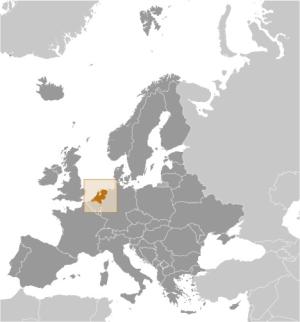The Dutch market potential for fresh fruit and vegetables
The Netherlands is a good market for developing-country suppliers, in particular for exporters of tropical fruit such as avocado, mango and banana. The dominant hub function and a growing domestic consumption make the Netherlands a promising export market. As a supplier, you can benefit from this by giving attention to sustainable production and offering specific market-focused solutions
Figure 1: Location of the Netherlands in Europe

Source: The World Factbook 2021. Washington, DC: Central Intelligence Agency, 2021.
2. What makes the Netherlands an interesting market for fresh fruit and vegetables?
Dutch importers form a main trade hub for fresh fruit and vegetables. About 20% of the fresh produce from developing countries find their way into Europe through the Netherlands. Domestic consumption had also increased on the verge of the COVID-19 pandemic.
The Netherlands is an important trade hub
The Netherlands plays an important role in the trade of fresh fruit and vegetables. The country is responsible for a fifth of all fresh fruit and vegetables imported into Europe, and most products are distributed throughout the rest of Europe. Exporters can use the Netherlands as a commercial or logistical trade hub.
The total export value of fresh fruit and vegetables of the Netherlands equals its total import and production value. This means that most fresh products are (re-)exported and additional value is created while doing so.
Rotterdam is home to the largest seaport in Europe. In this area, you will find logistical service providers such as Cool Control, LBP and Kloosterboer and a large number of trading companies. These companies offer a wide selection of services, from simple reselling to packing and ripening facilities and small distribution. Amsterdam airport is a gateway for air-freighted fruit and vegetables.
The main destinations of Dutch exports and re-exports are countries in northern Europe, Germany being by far the largest. For these countries, the Netherlands is one of the key suppliers of imported tropical fruit as well as fresh vegetables from both local and exotic origins. For exporters of off-season fruit and vegetables or more exotic varieties, Dutch traders offer an interesting distribution network in northern Europe and beyond.
Figure 2: The hub function of the Netherlands

Source: figure by ICI Business with data from Fresh Produce Centre
Dutch imports from developing countries are growing
The Netherlands is the largest European importer of fruit and vegetables from developing countries. With this, it takes a central position in the European market.
Although the highest volume of Dutch imports still comes from European countries, in trade value developing countries have surpassed European supplies (see Figure 3). Their value in Dutch imports reached €4.0 billion and represents around 20% of total European imports. This makes the Netherlands the main market for developing-country suppliers.
The current most dominant suppliers include Peru and South Africa with a very diverse offer, Brazil with mainly mangoes and melons and Costa Rica, mainly due to their leading exports in the banana and pineapple trade. Imports from Costa Rica, as well as Panama and Ecuador, have increased in the past five years. This was mainly because of a shift in banana logistics. For example, Chiquita has decided to transport their bananas through the port of Vlissingen in the south of the Netherlands. Colombia profited from a successful development of its avocado exports.
The import value from developing countries continues to increase, but the Dutch import share in the European market has also been increasing by 1% each year. You can expect the Netherlands to remain a key export market for foreign suppliers.
Consumption is growing during COVID-19
With 17 million inhabitants, the Netherlands is a mid-sized market in Europe. The Dutch do not excel in the consumption or consumption growth of fresh fruit and vegetables. The COVID-19 pandemic has turned this around causing a peak in household sales. The next few years will have to show if this consumption level will be maintained.
Over the past years, the Dutch consumption rate has been modest compared to the rest of Europe. In 2019, 58.2% of the consumers had a daily intake of at least 1 portion of fresh fruit and vegetables, compared to 67.1% on average in the European Union (see Table 1). At the same time, 29.5% of Dutch consumers say they eat more than 5 portions a day, one of the highest figures in Europe. The average daily consumption measured in 2012-2016 was 131 g of vegetables, 130 g of fruits, nuts and olives and 72 g of potatoes.
The COVID-19 pandemic has had a positive impact on the consumption of fresh fruit and vegetables. Out-of-home consumption fell due to lockdowns and the closing of restaurants, but Dutch households bought 9% more fruit and vegetables in 2020, leading to an overall consumption growth of 4%. Vitamin-rich fruit and vegetables such as oranges, kiwis, avocado, blueberries and peppers were particularly popular items. Online purchases, food boxes and meal kits increased as well. The consumption growth continued in 2021 with 4% more household sales of fresh vegetables and 3% more fruit in the first 6 months.



